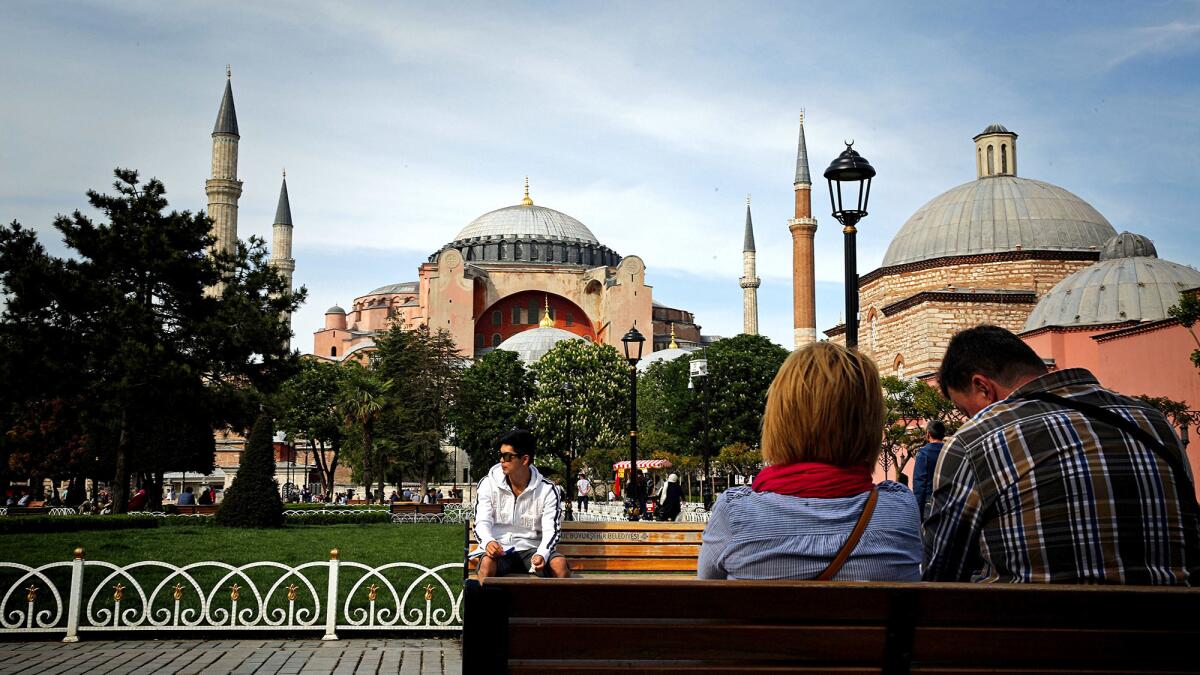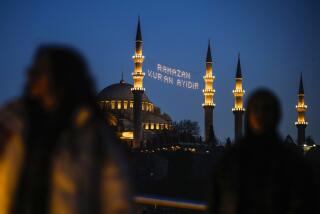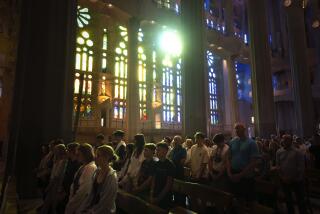Voices grow louder in Turkey to convert Hagia Sophia from a museum back to mosque

- Share via
Reporting from Istanbul, Turkey — As the time for afternoon prayers approaches, Onder Soy puts on a white robe and cap and switches on the microphone in a small 19th century room adjoining the Hagia Sophia.
Soon, Soy’s melodic call to prayer rings out over a square filled with tourists hurrying to visit some of Turkey’s most famous historical sights before they close for the day.
The room Soy is in — built as a resting place for the sultan and now officially called the Hagia Sophia mosque — fills up with around 40 worshipers, drawn not by the modestly decorated space itself, but by the ancient building it shares a wall with.
Built by the Byzantine Emperor Justinian I in AD 537, the Hagia Sophia was originally a Greek Orthodox basilica and one of the most important churches in all of Christendom. It became a mosque in 1453 after the Ottoman Empire defeated the Byzantines and took over Constantinople.
With the birth of a secular Turkish Republic, the Hagia Sophia became a museum in 1935, meant to highlight the shared legacy of the space for the world’s two largest religions. But, eight decades later, the fate of this building still tugs at the hearts of Muslims and Christians alike.
In October, Turkey’s Directorate of Religious Affairs appointed Soy as the full-time imam for the room adjoining the Hagia Sophia, a space that opened in 1992 but was previously only meant for workers in the area to use for prayers.
Five times a day now, Soy’s voice rings out, not just as a call to daily prayer, but also as an audible reminder for many Muslims in Turkey that their long-held dream of worshiping inside the Hagia Sophia may become a reality.
This June, three separate groups led marches to the museum calling for its opening as a mosque. One group began a campaign asking people to remove their shoes before they enter the building, just as they would when entering a mosque.
“I have never entered the Hagia Sophia and I never will until it is reopened as a mosque,” said Emrullah Celik, 29, an activist who has helped lead a small but influential grassroots campaign to have the building converted to a mosque. “We want to enter with a prayer rug, not with a ticket.”
“It’s not like the stones of the Hagia Sophia are holy, there is nothing inside it that makes it special, but God told us it is important,” said Salih Akyuz, the head of the youth branch of the Saadet Party, one of several Islamist groups that led a march to the Hagia Sophia on May 29, the 564th anniversary of the Ottoman conquest of Constantinople. “We were taught by our prophet Muhammad that Constantinople was an important place, and this was the most important place in the city, so it is dear to our hearts.”
Outside the Hagia Sophia, two women walk past Soy and purchase tickets to enter the museum. One places a shawl over her head and briefly kneels to make the sign of the cross, her eyes fixed on a glimmering 9th century mosaic above the basilica’s Imperial Door.
Thousands of marble squares, semiprecious stones, and cut glass in dozens of colors depict Christ seated on a throne, flanked by the Virgin Mary and the Archangel Gabriel, with the Byzantine Emperor Leo VI kneeling, cherishing the chance to kiss Christ’s feet.
For nearly a thousand years, the Imperial Door — made of wood that some believe came from Noah’s Ark — was opened only for emperors.
Justinian I was reportedly hoping to outdo Solomon’s Temple, and to many of those who visited the Hagia Sophia over the centuries, he succeeded.
A series of semicircles draw the eye to the center of the space and a 108-foot-wide dome is set on 40 windows that seems to float some 200 feet in the air.
Three aisles running east to west are separated by rows of massive Corinthian columns topped with leaves and scrolls so elaborate it is difficult to fathom they were carved in stone.
The floor has been weathered so smooth by 14 centuries of visitors, in some places signs remind you that it is slippery.
Nearly every Byzantine emperor until 1453 was crowned in the Hagia Sophia. In 1054, a representative of the Latin Pope Leo IX marched up to the central altar and declared the patriarch of Constantinople excommunicated, marking the beginning of the Great Schism that would separate the Eastern Orthodox and Roman Catholic faiths.
The basilica’s most awe-inspiring contents have been the nearly four acres of mosaics that once covered its walls, most of which were obscured during Ottoman rule to adhere to a strict Islamic ban on images inside mosques. But even as a mosque, visitors could often peer up at giant mosaics of angels with their faces obscured, or make out Greek crosses inside the painted designs encircling them that were meant to convert them into benign geometric patterns.
We want to enter with a prayer rug, not with a ticket.
— Emrullah Celik, an activist who has led a grassroots campaign to convert the Hagia Sophia to a mosque
With the rise in popularity in Turkey of Ottoman-themed television shows and the promotion of the nation’s imperial heritage by the ruling AK Party, the marches and similar rallies at the Hagia Sophia have become increasingly frequent.
At the May 29 march, a man dressed in royal regalia meant to mimic that of Ottoman Sultan Mehmet II, rode a white horse along the route that was used by the sultan’s soldiers in 1453 as they breached the city walls and headed for the Hagia Sophia.
At a side door to the museum today, a saying attributed to Muhammad is found in intricate gold calligraphy: “You [my followers] will conquer Constantinople, and the leader who does so will be great, and his army will be great.”
Muhammad’s immediate successors tried unsuccessfully to take the city, as did a long line of Ottoman leaders before it finally fell to Mehmet II, whose tomb, two miles away, is a popular pilgrimage point for the pious.
Nearly 3.5 million people visit the Hagia Sophia annually, making it the most popular tourist attraction in Turkey. But not everyone in Turkey is eager to see the treasures inside.
In the predawn hours, Celik and a few dozen young men and women gathered before the museum entrance, and had a picnic breakfast, the last meal before the start of a Ramadan fast.
“If now is not the right time, when is?” Celik asked.
While President Recep Tayyip Erdogan has held off on announcing any retooling of the Hagia Sophia, Islamists see hopeful signs, like the opening of the full-time mosque in the small adjoining room.
As Celik and the others gulped down glasses of water in preparation for the fast, a TV news satellite van parked nearby carried a live feed from inside the Hagia Sophia.
The show, broadcast nationally since last year, features a soft-spoken host interviewing a rotating cast of academics, historians and religious scholars. The last half-hour features a recitation of the Koran inside the museum, the only occasion on which such a practice has been allowed by authorities.
Celik helped spark the current round of interest around the Hagia Sophia. In May 2014, he and a handful of activists organized an early morning march on the museum that ended up drawing thousands.
“At the time, it was a hot topic, and me and a group of young activists were thinking, how can we get people to be more interested, to put more pressure on our leaders?” said Celik.
After the march, the Greek government and the leadership of the Greek Orthodox Church condemned the proposal to turn the building into a mosque. Meanwhile, one Islamist group, the Anatolia Youth Assn., collected more than 15 million signatures on a petition calling for the mosque to be reopened.
A bill to do so was introduced in parliament, only to be quietly withdrawn by the ruling AK Party. Erdogan, then prime minister, who has built his political career on empowering conservative Muslims in Turkey, rebuffed Celik and the other activists, saying they should first fill the nearby Blue Mosque with worshipers before turning to the Hagia Sophia.
On other occasions, Erdogan has said he would like to see the Hagia Sophia eventually become a mosque, but the president’s pace, and real motivations for such rhetoric, does not impress Islamist activists like Celik.
“If the issue was about filling mosques, why is Erdogan building the Camlica mosque? How is he going to fill that?” said Celik, referring to a new mosque nearing completion on a hill overlooking Istanbul that will be the largest in the country.
“It’s a political issue in Turkey, and the AK Party has taken some steps so far to make it [the Hagia Sophia] a mosque, but that has not been enough.”
If Mehmet II’s conversion of the church to a mosque in the 15th century was a turning point, Celik says, Turkey is ready today for a new historic moment.
“For us, 1453 was a symbol of Islam winning over Christianity,” said Celik. “Now, for those who want to keep the Hagia Sophia a museum — I think a very small number of people — it’s a symbol of secularism winning over Islam. But Turkey has changed, and they are out of touch with it.”
Umar Farooq is a special correspondent.
More to Read
Sign up for Essential California
The most important California stories and recommendations in your inbox every morning.
You may occasionally receive promotional content from the Los Angeles Times.













